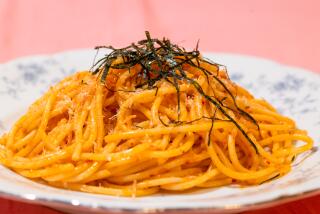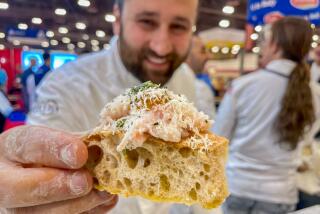Pasta breaks with tradition to drop carbs, boost protein and more
- Share via
Gianluca Mech was aware of the irony of bringing diet pasta to his compatriots in Italy, persuading them to trade their traditional spaghetti for a high-protein, low-carb alternative — a recent entry in a category of pasta made from all sorts of grains other than wheat, as well as beans and vegetables.
But 15 years on, his diet line, Tisanoreica, is in about 5,000 shops around Italy and is making its U.S. debut.
Rome-based Mech, whose family has been making a line of herbal extracts for 500 years, says he came up with the pasta idea after his father died of obesity-related illnesses.
“We don’t work in the fields with our hands like in the past, and on the other hand we cannot renounce our traditional foods,” said Mech, in Los Angeles recently to oversee the launch of the brand, which he describes as “the Italian comfort food diet.”
Mech worked with scientists at the University of Padua, near Venice, to reformulate pasta, replacing the traditional semolina or durum flour with isolated soy and pea proteins, mallow, star anise, fennel, artichoke, dandelion and papaya. The same ingredients are in the brand’s risotto, breads, desserts and other products. The result is pasta that has the same caloric value as its conventional counterpart but with fewer carbs and more protein: 2 ounces of Tisanoreica’s dry fusilli has 170 calories, 4 grams of carbohydrates and 33 grams of protein, compared with a conventional durum fusilli with 200 calories, 41 grams of carbohydrates and 8 grams of protein. Mech’s pasta is pricey: 8 ounces of conventional dried pasta can be had for a dollar; 8.8 ounces of Tisanoreica’s pasta is $17.50.
Tisanoreica pastas are on the menus at several Italian restaurants, including Il Pastaio in Beverly Hills, and at stores such as Pacific Coast Greens in Malibu.
The taste of the Tisanoreica pasta is close to whole wheat pasta; it’s chewier than regular varieties, and with the additional fiber, it takes less to feel full.
Pasta is being reimagined in many ways, for people who don’t eat wheat or who follow a Paleo diet or who shun carbs as if they were arsenic. Pasta made from rices, quinoa and beans are widely available. The textures can be chewier or soggier than regular pasta, and tastes vary.Restaurants have caught onto the trend as well; Mauro’s Cafe at Fred Segal serves “pasta” made of shredded cabbage, and True Food Kitchen in Santa Monica has a cheesy pasta-like casserole made from strands of spaghetti squash. Hugo’s Restaurants offers penne made from red lentils.
Alternative pastas are a growing product category, said Tim Fanning, grocery coordinator for the Southern Pacific region of Whole Foods Market. “We’re getting more and more customers coming in looking for options. It used to be just gluten-free, but now we can have pastas made from lentils or pure fiber that is low in carbs and calories.”
But not all carbohydrates are bad, nutritionist and trainer Kathy Kaehler says. “People have shunned carbs when the reality is complex carbs are our body’s fuel. When pasta is part of a meal in the appropriate serving size, there is nothing wrong with it.”
More to Read
Eat your way across L.A.
Get our weekly Tasting Notes newsletter for reviews, news and more.
You may occasionally receive promotional content from the Los Angeles Times.










